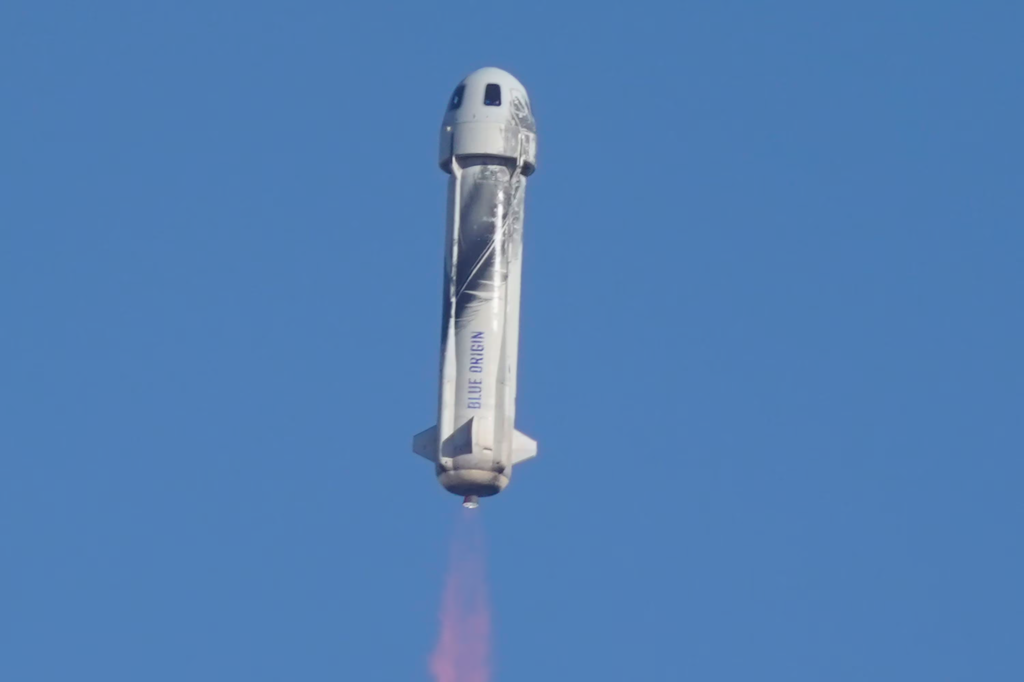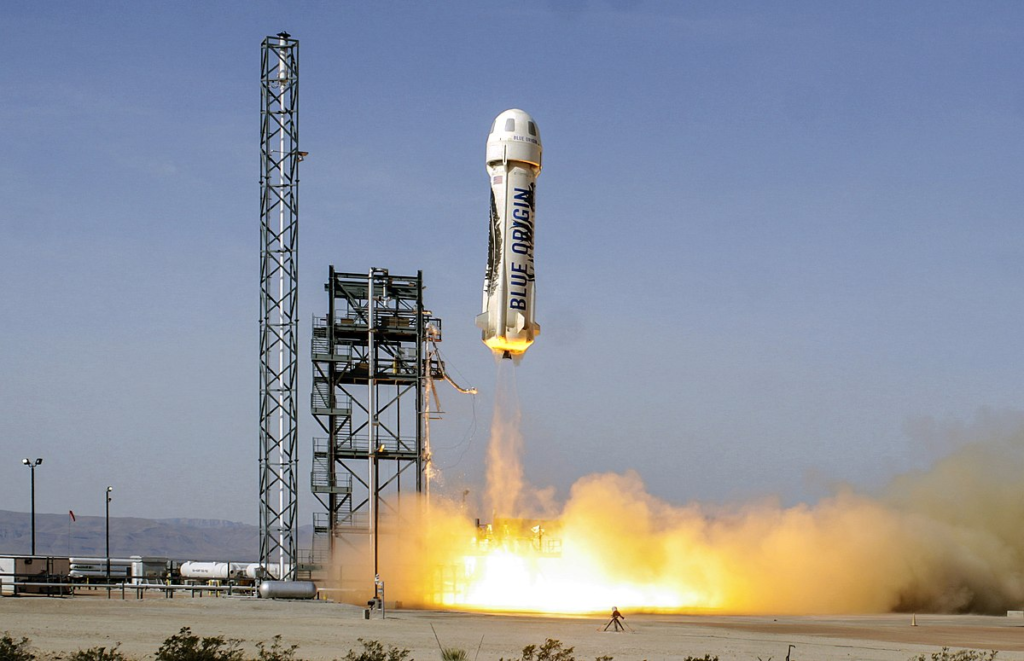
What Exactly Went Wrong With Blue Origin’s New Shepard?
Blue Origin has been launching the New Shepard spacecraft for close to 8 years now. The purpose of this small rocket is to send 6 people to the edge of space and also allow the company to test a propulsive booster landing among other things. Around 6 months ago Blue Origin launched an uncrewed New Shepard apart of the NS23 mission.
This time, however, the short mission did not go to plan. Soon after liftoff, the booster suffered an anomaly and the capsule escape system ignited. The capsule then landed safely while the booster fell toward the ground before impact. While there was no crew aboard, this was obviously still a big deal as crew often flies on New Shepard.
In the time since this failure, Blue Origin has halted the program and revealed very little information on exactly what happened. Thankfully, various sources and statements can make out the general problem and what Blue Origin is working on. Here I will go more in-depth into the initial failure, new statements from Blue Origin, the future of this program, and more.
6 Month Investigation

Back on September 12th Blue Origin said in a statement “Booster failure on today’s uncrewed flight. Escape system performed as designed.” During the mission, the company’s uncrewed New Shepard capsule activated its emergency escape system after a problem occurred with the New Shepard booster a little before the mission reached an altitude of 30,000 feet (9,000 meters). The rocket lifted off at 10:27 a.m. EDT (1427 GMT) after being delayed nearly an hour. Video from Blue Origin of the launch cut away from the booster shortly after the anomaly occurred 1 minute and 5 seconds after launch, focusing on the capsule instead of the booster. Soon after the capsule deployed its parachutes and landed back on the ground.
Thankfully, the capsule was carrying 36 payloads rather than humans. Either way, this error was enough to completely halt the program until Blue Origin figured out exactly what happened. By now in the middle of March, Blue Origin is still investigating the failure. Only a few weeks ago Blue Origin’s Gary Lai, the chief architect for New Shepard mentioned, “We are investigating that anomaly now, the cause of it. “We will get to the bottom of it,” Lai added. “I can’t talk about specific timelines or plans for when we will resolve that situation, other than to say that we fully intend to be back in business as soon as we are ready.”
For the most part, New Shepard flights are very brief, lasting just 10 to 12 minutes from liftoff to capsule touchdown. In this short time period, passengers get to experience a few minutes of weightlessness and see the curve of Earth against the blackness of space. Blue Origin has not disclosed how much it charges for a seat on the vehicle. It’s also important to point out that Blue Origin has used different New Shepard vehicles for crewed versus uncrewed flights. All six passenger missions have employed the New Shepard RSS First Step, whereas the recent payload-only launch used the RSS H.G. Wells. Not to mention, Booster 3, which launched the failed mission in September, was the company’s oldest operational rocket, making its debut in December 2017. The company has used its newest rocket, Booster 4, exclusively for human launches. It has some modifications from Booster 3 to qualify it as a human-rated rocket.
As far as the response to this failure, just three days after the accident with the New Shepard-23 mission, the bipartisan leadership of the House Subcommittee on Space and Aeronautics sent a letter to the Federal Aviation Administration, calling for a thorough investigation. The chair of the subcommittee said in a quote, “I’m heavily in favor of transparency, and I’m hoping that the FAA comes through pretty quickly with this. I would strongly encourage Blue Origin to be as transparent as possible, because that builds trust. It doesn’t have to be overnight, but it would be nice to keep people updated on the progress they’re making.” Unfortunately, this has not been the case at all with very little information being released even 6 months later.
Even though this was only the second in-flight anomaly for New Shepard this was much more serious considering the first and only other incident occurred on the vehicle’s debut launch in 2015. On that occasion, the booster crash-landed and was destroyed, but the capsule managed to reach suborbital space as planned. Still a better result than the most recent mission based on the timeline and circumstances. Something Blue Origin is continuing to look at and figure out.
New Shepard’s Future

Despite this failure and the continued investigation, Blue Origin is still looking at the future of New Shepard and what it has to offer. They are even focusing on a future filled with more human flights on the rocket rather than payloads like on the most recent mission. In another quote, Gary Lai commented, “We expect that in the near future, the coming year, suborbital tourism will dominate our flights,” predicting that Blue Origin will support “about a couple” dedicated payload missions a year, the same as it has, even as the number of private astronaut flights grows.
Eric Berger reported that “Based on an application filed with the Federal Communications Commission in January, it appeared that Blue Origin might be targeting a time period from April 1 to June 1 of this year for its next New Shepard flight. However, a spokesperson for the company said not too much should be read into this date, as it is not tied to a specific launch. “As a matter of course, we submit rolling FCC license requests to ensure we have continuous coverage for launches,” the spokesperson said.”
New Shepard even has some plans with NASA related to artificial gravity. At one-sixth that of Earth, the unique gravity of the lunar surface is one of the many variable conditions that technologies bound for the Moon will need to perform well in. NASA is hoping to have more options for testing those innovations in lunar gravity thanks to a collaboration with Blue Origin to bring new testing capabilities to the company’s New Shepard reusable suborbital rocket system. Currently, NASA can approximate the Moon’s gravity on parabolic flights and in centrifuges on suborbital vehicles – both invaluable options for maturing promising innovations. But these methods provide only seconds of lunar gravity exposure at a time or limit the payload size, compelling NASA to explore longer-duration and larger size options. Blue Origin’s new lunar gravity testing capability – projected to be available in late 2022 – is answering that need.
New Shepard’s upgrades will allow the vehicle to use its reaction control system to impart a rotation on the capsule. As a result, the entire capsule essentially acts as a large centrifuge to create artificial gravity environments for the payloads inside. Blue Origin’s first flight of this capability will target 11 rotations per minute to provide more than two minutes of continuous lunar gravity, exposing the technologies to this challenging but difficult-to-test condition. This new capability is made possible with the help of development funding and early purchase of payload space by NASA as part of its strategic investment in the U.S. spaceflight industry. The lunar gravity simulation will enable the agency to test and de-risk innovations critical to achieving the goals of the Artemis program, as well as lunar surface exploration and Moon-bound commercial applications.
“NASA is pleased to be among the first customers to take advantage of this new capability,” said Christopher Baker, program executive for the Flight Opportunities program at NASA Headquarters in Washington. “One of the constant challenges with living and working in space is reduced gravity. Many systems designed for use on Earth simply do not work the same elsewhere. A wide range of tools we need for the Moon and Mars could benefit from testing in partial gravity, including technologies for in-situ resource utilization, regolith mining, and environmental control and life support systems.”
New Shepard is currently among the commercial flight platforms available for technology flight testing contracted by NASA’s Flight Opportunities program. The program has helped mature hundreds of promising space-based technologies from NASA, industry, and academia by putting them through their paces on commercial suborbital vehicles before they move on to higher risk orbital missions – on CubeSats, the International Space Station, the Moon, or even Mars. New Shepard’s future lunar gravity capability will expand the suborbital flight test offerings not only for the company but for the Flight Opportunities program as well, adding to the specialized testing available for the technologies selected for testing by the program each year. “Humanity has been dreaming about artificial gravity since the earliest days of spaceflight,” said Erika Wagner, PhD, New Shepard director of payloads at Blue Origin. “It’s exciting to be partnering with NASA to create this one-of-a-kind capability to explore the science and technology we will need for future human space exploration.” With all this being said, it’s unclear exactly how the recent failure will affect this future plan and goal. It will most definitely add delays which we will see as time goes on.
Conclusion
Blue Origin is still in the process of investigating New Shepard and trying to figure out what went wrong and how to prevent it on future missions. Despite this, they are confident in a busy New Shepard future filled with human flights. We will have to wait and see how it progresses and the impact it has on the space industry.
